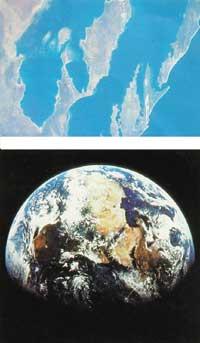Montreal 87 Basque Country 97
Background

In September 1984 the Greek University of Thessaloniki organized an international symposium on ozone. In it the Japanese researcher Sigeru Chubachi released the studies carried out in 1982 in the South Pole. According to him, the decrease in ozone levels was remarkable compared to previous years. A few months later, specifically in May 1985, researchers Joseph Farman, Brian Gardiner and Joseph Shanklin of the British Antartic Survey published in the journal Nature the results of their research in the atmosphere of the South Pole between 1980 and 1984. They also showed the lack of ozone and also highlighted the presence of abnormal chlorine.
Conducting similar diagnoses in such a short term has shaken the interest of researchers around the world. NASA also reviewed data provided by the Nimbus-7 satellite for many years. Apparently, the satellite did not detect rare data, but a more comprehensive study alerted satellites with very small numbers recorded every month of September and October, but these non-normal data were attributed to device failures.
We can say that 1986 was a year of debate. Numerous theories were presented trying to understand ozone shortage, but by the end of that year most research considered CFC substances guilty.
In the first quarter of the following year the scientific community confirmed, almost unanimously, the influence of CFCs. This decision made by scientists was not contrary and both politicians and industrialists began to prepare for the change of trade status of CFCs.
| Composition Gas (millions) (by volume) | Composition (millions) (by weight) | |
Nitrogen | 780900 | 755100 |
Oxygen | 209500 | 231500 |
Argon | 9300 | 12800 |
Carbon dioxide | More information | 460 |
Neon | Other | 12.5 |
Helium | 5.2 | 0.72 |
Methane | More information | 0.94 |
Cripton | 1. | 2.9 |
Nitrogen oxide | 0.5 | 0.8% |
Hydrogen | 0.5 | 0.035 |
Ozone | 0.4 | More information |
Xenon | 0.08 | 0.36 |
This trend materialized in the agreement signed in 1987 in Montreal. 55 developed world states participated and 27 signed an agreement to reduce the production of CFCs. This agreement forced the production of 2000 to be brought in mid-1986.

The developed states were, above all, those who signed the agreement and those in the process of development retreated. In fact, advanced states had more economic means to deal with possible transitions, but signing an agreement for the rest required the suspension of comprehensive economic programs. As an example, the case of China, whose authorities for the year 2000 had planned the possibility of each Chinese family having a refrigerator in their home, so compliance with the Montreal agreement involved the suspension of planning, so they resigned their signature.
However, in these ten years the situation has accelerated. Currently the CFCs are barely produced and industry and consumption have adapted very well to the new situation. In developing States, the introduction of alternative substances to CFCs is easier than expected, so it can be said that not only has the agreed in Montreal been fulfilled, but it has also been overcome.
Ozone physics and chemistry
Analyzing minerals from 1.8 billion years ago it can be said that at that time there was oxygen in the air. Over the years, oxygen levels increased and when it reached 1% of the current concentration, the ozone layer began to form.
The chemical formula of ozone is O 3. For the formation of this chemical compound, composed of oxygen, two conditions are mainly required: oxygen and energy. Chapman was the first to shape ozone:
O + 2
The way to obtain monoatomic oxygen is the dissociation of molecular oxygen, but energy is needed for this. Most of the energy in the atmosphere comes from the Sun. Therefore, Chapman demonstrated in the laboratory the influence of ultraviolet rays and discovered that ultraviolet rays of less than 240 nm separate the oxygen molecule.
Therefore, ozone formation requires oxygen and energy. Oxygen formation is directly proportional to the number of plants due to chlorophyll function. The largest vegetation is among the tropics, that is, in the Amazon, south of Asia, etc. On the other hand, the place most affected by solar rays is also the tropic. Therefore, it can be said that the greatest amount of ozone occurs on the intertropical lands.
The ozone produced in the stratosphere extends to the entire Earth and surrounds it like an orange skin. The density of this gas is 1.66 and liquidated to -112°C. As for the vertical distribution, it extends from the km. 10 to km. 50 with a maximum concentration around km. 20.

Anything in nature influences our ecological balance. However, some substances are more important than others. Ozone protects us from ultraviolet rays from the Sun, that is, it has the function of a filter. In particular it filters the ultraviolet rays of wavelength less than 290 nm. If the minor ultraviolet rays of this wavelength hit the Earth, it would not be the life we know today. This is because genetic changes, skin cancer and mutations would occur in optimal conditions.
This is not the only task performed by ozone, which although it has to do with the greenhouse effect, on the earth's surface does not reach at all the importance of the aforementioned task.
Nature of CFC substances
In 1974 researchers Molina and Rowland demonstrated that a chlorine atom can eliminate 100,000 ozone molecules. The chain of reaction that represents this phenomenon is as follows:
More information
Teaching Hall
These reactions indicate that when radical chlorine finds the ozone molecule it combines with it, forming chlorine oxide and oxygen molecule. It is then combined with the radical oxygen found by chlorine oxide, forming radical chlorine and oxygen molecule. Therefore, radical chlorine is again free and ready to join another ozone molecule.
This cyclical process, as mentioned above, can be repeated up to 100,000 times on average. It was quickly proven that stratospheric chlorine had its origin in CFC substances, so it is advisable to know its characteristics in the substance. CFC substances are hydrocarbons containing chlorine and fluorines. They were developed by General Motors around 1930. However, the industrial use of CFCs did not occur until the end of World War II. Between 1945 and 1974 the average increase in production was 13% annually. Thus, in late 1974 CFC 11 production amounted to 370,000 tons and CFC 12 to 443,000 tons. The peak production of these substances occurred around 1985: The estimated production for this year was 1,150,000 tons.
Data on the use of these substances also indicate an evolution. Until 1970 the main use of CFCs was located in the aerosol industry. Currently a third of its use is intended. As sprays we can find them in cosmetic products, pharmaceuticals, insecticides, lacquers, deodorants, etc. as CFC 11, CFC 12 and CFC 22.
The second main use is in synthetic foams, i.e. polyurethanes, polystyrene and polyethylene. The most commonly used substances are CFC 11, CFC 12 and CFC 114. These foams are mainly used in coatings, insulation and automotive.

Third and last, the set of applications are in refrigeration and air conditioning. They are used in large and small refrigeration facilities CFC 11, CFC 12, CFC 22, CFC 113 and CFC 114, both as insulation insulators of cold rooms and as refrigerant substances, ie freones, etc. like.
The following table shows two characteristics of the different CFCs. On the one hand, the living mean of each substance and, on the other, the ozone exposure index.
The substances in this table are the most commonly used. Among them, CFCs 11 and 12 account for 80% of total production. The greatest damage is also due to these. Therefore, to say that the mean life of CFC substances is 100 years is not far from reality.
The contribution of data on the life of these substances is very important to explain their influence in the stratosphere. It is estimated that when CFCs are emitted into the atmosphere it takes about 20 years to reach the stratosphere. When they reach the stratosphere, due to present wind currents, they extend to the stratosphere of the entire Earth.
According to this, the CFCs currently affecting the stratosphere have been issued during 1975. As the peak of production occurred in 1985, it is easy to conclude that the concentration of CFC substances in the stratosphere will be higher than that which has existed sometimes within about ten or fifteen years. If we add to this data the middle life, the XXI. It is noted that in the nineteenth century the ozone layer can have a very worrying future.
The most real hypothesis
So far, the clear decrease in the ozone layer has only occurred in the South Pole and, according to some studies, the first effects have been noticed especially in the nearby sea, the main being the decrease in the reproduction of the fish.
However, what was scientifically expected from the accumulation of CFC substances is not happening, that is, instead of the ozone decrease increasing uninterruptedly, in some years very small declines have occurred. This fact, despite being a hopeful fact in itself, indicates that the phenomenon is not known too well and that, although it is known, some data have not been published, especially for reasons of political or economic interest.
| Name | Life (years) | Index of condition |
CFC 11 | More information | 1.0 |
CFC 12 | 150% | 0.89 |
CFC 113 | 100% | 0.85 |
CFC 114 | More information | 0.79 |
CFC 115 | 650 | 0.40 |
However, the social alarm has brought about a strengthening of environmental awareness and, above all, the natural incorporation into the education and life of young generations of the problems closest to ozone, greenhouse effect or recycling.
On the other hand, the internationality of ecology has been strengthened, because we must not forget that what is happening at this time in the Amazon or the South Pole can directly influence our lives.
Buletina
Bidali zure helbide elektronikoa eta jaso asteroko buletina zure sarrera-ontzian











